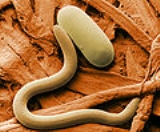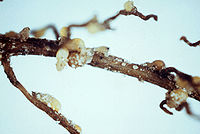
Soybean cyst nematode
Encyclopedia
The soybean cyst nematode (SCN), Heterodera glycines, is a plant-parasitic nematode
and a devastating pest of the soybean
(Glycine max) worldwide. The nematode infects the roots of soybean, and the female nematode eventually becomes a cyst
. Infection causes various symptoms that may include chlorosis of the leaves and stems, root necrosis, loss in seed yield and suppression of root and shoot growth. SCN has threatened the U.S. crop since the 1950s, reducing returns to soybean producers by $500 million each year and reducing yields by as much as 75 percent. It is also a significant problem in the soybean growing areas of South America
and Asia
.
s to the vascular tissue where it feeds. The J2 induces cell division
in the root to form specialized feeding sites. As the nematode feeds, it swells. The female swells so much that her posterior end bursts out of the root and she becomes visible to the naked eye. In contrast, the adult male regains a wormlike shape, and he leaves the root in order to find and fertilize the large females. The female continues to feed as she lays 200 to 400 eggs in a yellow gelatinous matrix, forming an egg sac which remains inside her. She then dies and her cuticle hardens forming a cyst. The eggs may hatch when conditions in the soil are favorable, the larvae developing inside the cyst and the biological cycle repeating itself. There are usually three generations in the year. In the autumn or in unfavorable conditions, the cysts containing dormant larvae may remain intact in the soil for several years. Although soybean is the primary host of SCN, other legume
s can also serve as hosts.

. It was first found in the United States
in 1954 and spread with the expansion of soybean growing areas. SCN was also found in Colombia
in the 1980s, and more recently in the major soybean producing areas in Argentina
and Brazil
. SCN has also been reported from Iran and Italy.
and the use of resistant cultivars, are used to limit the damage due to SCN. Because SCN is an obligate parasite (requires a living host), a crop rotation involving non-host plants can decrease the population of SCN and has been shown to be an effective management tool. Plants that are already stressed are more susceptiable to infection, so good cultural practices, like maintaining soil fertility, pH and moisture can reduce the severity of infection. Chemical control with nematicides is not normally used because the economic and environmental costs are prohibitive.
Nematode
The nematodes or roundworms are the most diverse phylum of pseudocoelomates, and one of the most diverse of all animals. Nematode species are very difficult to distinguish; over 28,000 have been described, of which over 16,000 are parasitic. It has been estimated that the total number of nematode...
and a devastating pest of the soybean
Soybean
The soybean or soya bean is a species of legume native to East Asia, widely grown for its edible bean which has numerous uses...
(Glycine max) worldwide. The nematode infects the roots of soybean, and the female nematode eventually becomes a cyst
Cyst
A cyst is a closed sac, having a distinct membrane and division on the nearby tissue. It may contain air, fluids, or semi-solid material. A collection of pus is called an abscess, not a cyst. Once formed, a cyst could go away on its own or may have to be removed through surgery.- Locations :* Acne...
. Infection causes various symptoms that may include chlorosis of the leaves and stems, root necrosis, loss in seed yield and suppression of root and shoot growth. SCN has threatened the U.S. crop since the 1950s, reducing returns to soybean producers by $500 million each year and reducing yields by as much as 75 percent. It is also a significant problem in the soybean growing areas of South America
South America
South America is a continent situated in the Western Hemisphere, mostly in the Southern Hemisphere, with a relatively small portion in the Northern Hemisphere. The continent is also considered a subcontinent of the Americas. It is bordered on the west by the Pacific Ocean and on the north and east...
and Asia
Asia
Asia is the world's largest and most populous continent, located primarily in the eastern and northern hemispheres. It covers 8.7% of the Earth's total surface area and with approximately 3.879 billion people, it hosts 60% of the world's current human population...
.
Biology
The second-stage juvenile, or J2, nematode is the only life stage that can penetrate roots. (The first-stage juvenile occurs in the egg, and third- and fourth-stages occur in the roots). The J2 enters the root moving through the plant cellPlant cell
Plant cells are eukaryotic cells that differ in several key respects from the cells of other eukaryotic organisms. Their distinctive features include:...
s to the vascular tissue where it feeds. The J2 induces cell division
Cell division
Cell division is the process by which a parent cell divides into two or more daughter cells . Cell division is usually a small segment of a larger cell cycle. This type of cell division in eukaryotes is known as mitosis, and leaves the daughter cell capable of dividing again. The corresponding sort...
in the root to form specialized feeding sites. As the nematode feeds, it swells. The female swells so much that her posterior end bursts out of the root and she becomes visible to the naked eye. In contrast, the adult male regains a wormlike shape, and he leaves the root in order to find and fertilize the large females. The female continues to feed as she lays 200 to 400 eggs in a yellow gelatinous matrix, forming an egg sac which remains inside her. She then dies and her cuticle hardens forming a cyst. The eggs may hatch when conditions in the soil are favorable, the larvae developing inside the cyst and the biological cycle repeating itself. There are usually three generations in the year. In the autumn or in unfavorable conditions, the cysts containing dormant larvae may remain intact in the soil for several years. Although soybean is the primary host of SCN, other legume
Fabaceae
The Fabaceae or Leguminosae, commonly known as the legume, pea, or bean family, is a large and economically important family of flowering plants. The group is the third largest land plant family, behind only the Orchidaceae and Asteraceae, with 730 genera and over 19,400 species...
s can also serve as hosts.

Pathology
The aboveground symptoms of SCN infection are not unique to SCN infection, and could be confused with nutrient deficiency, particularly iron deficiency, stress from drought, herbicide injury or another disease. The first signs of infection are groups of plants with yellowing leaves that have stunted growth. The pathogen may also be difficult to detect on the roots, since stunted roots are also a common symptom of stress or plant disease. Observation of adult females and cysts on the roots is the only accurate way to detect and diagnose SCN infection in the field.Distribution
The SCN is thought to be a native of AsiaAsia
Asia is the world's largest and most populous continent, located primarily in the eastern and northern hemispheres. It covers 8.7% of the Earth's total surface area and with approximately 3.879 billion people, it hosts 60% of the world's current human population...
. It was first found in the United States
United States
The United States of America is a federal constitutional republic comprising fifty states and a federal district...
in 1954 and spread with the expansion of soybean growing areas. SCN was also found in Colombia
Colombia
Colombia, officially the Republic of Colombia , is a unitary constitutional republic comprising thirty-two departments. The country is located in northwestern South America, bordered to the east by Venezuela and Brazil; to the south by Ecuador and Peru; to the north by the Caribbean Sea; to the...
in the 1980s, and more recently in the major soybean producing areas in Argentina
Argentina
Argentina , officially the Argentine Republic , is the second largest country in South America by land area, after Brazil. It is constituted as a federation of 23 provinces and an autonomous city, Buenos Aires...
and Brazil
Brazil
Brazil , officially the Federative Republic of Brazil , is the largest country in South America. It is the world's fifth largest country, both by geographical area and by population with over 192 million people...
. SCN has also been reported from Iran and Italy.
Locations
- AfricaAfricaAfrica is the world's second largest and second most populous continent, after Asia. At about 30.2 million km² including adjacent islands, it covers 6% of the Earth's total surface area and 20.4% of the total land area...
: Egypt - AsiaAsiaAsia is the world's largest and most populous continent, located primarily in the eastern and northern hemispheres. It covers 8.7% of the Earth's total surface area and with approximately 3.879 billion people, it hosts 60% of the world's current human population...
: China (Hebei, Hubei, Heilongjiang, Henan, Jiangsu, Liaoning), Indonesia (Java), Korean peninsula, Japan, Taiwan (unconfirmed), Russia (Amur District in the Far East). - North AmericaNorth AmericaNorth America is a continent wholly within the Northern Hemisphere and almost wholly within the Western Hemisphere. It is also considered a northern subcontinent of the Americas...
: Canada (Ontario), USA (Alabama, Arkansas, Delaware, Florida, Georgia, Illinois, Indiana, Iowa, Kansas, Kentucky, Louisiana, Maryland, Minnesota, Michigan, Mississippi, Missouri, Nebraska, New Jersey, North Carolina, North Dakota, Ohio, Oklahoma, Pennsylvania, South Carolina, South Dakota, Tennessee, Texas, Virginia and Wisconsin). - South AmericaSouth AmericaSouth America is a continent situated in the Western Hemisphere, mostly in the Southern Hemisphere, with a relatively small portion in the Northern Hemisphere. The continent is also considered a subcontinent of the Americas. It is bordered on the west by the Pacific Ocean and on the north and east...
: Argentina (unconfirmed), Brazil (unconfirmed), Chile, Columbia, Ecuador.
Control
Cultural practices, such as crop rotationCrop rotation
Crop rotation is the practice of growing a series of dissimilar types of crops in the same area in sequential seasons.Crop rotation confers various benefits to the soil. A traditional element of crop rotation is the replenishment of nitrogen through the use of green manure in sequence with cereals...
and the use of resistant cultivars, are used to limit the damage due to SCN. Because SCN is an obligate parasite (requires a living host), a crop rotation involving non-host plants can decrease the population of SCN and has been shown to be an effective management tool. Plants that are already stressed are more susceptiable to infection, so good cultural practices, like maintaining soil fertility, pH and moisture can reduce the severity of infection. Chemical control with nematicides is not normally used because the economic and environmental costs are prohibitive.
External Links
- Species Profile- Soybean Cyst Nematode (Heterodera glycines), National Invasive Species Information Center, United States National Agricultural LibraryUnited States National Agricultural LibraryThe United States National Agricultural Library is one of the world's largest agricultural research libraries, and serves as a National Library of the United States and as the library of the United States Department of Agriculture...
. Lists general information and resources for Soybean Cyst Nematode.

